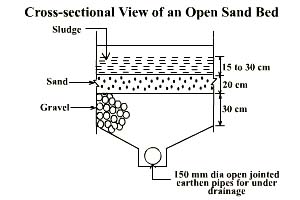Home
Lecture
Quiz
Design Example |
Residual Management
Sludge Dewatering Methods
Disposal of Sludge
Sludge Characteristics
Sand Beds for Sludge Drying
Residual Management
In all biological waste treatment processes some surplus sludge is produced. The objective of residual management is:
- Reduction of water content.
- Stabilization of sludge solids.
- Reduction in sludge solids volume.
In facultative type aerated lagoons and algal waste stabilization ponds, the surplus sludge settles out in the unit itself and is removed only once in a few years after emptying the unit, exposing the wet sludge to natural drying, and carting away the dried sludge for agricultural use or land filling.
In extended aeration process where aerobic digestion of surplus sludge is done, the sludge can be taken directly for dewatering and disposal.
In case of activated sludge and trickling filter plants, the sludge is taken (along with the primary sludge) to a sludge digester for further demineralization and thereafter it is dewatered.
Sludge Dewatering Methods
- Natural: sludge drying beds, sludge lagoons
- Mechanical: sludge thickeners, centrifuges, vacuum filters, filter press
- Physical: heat drying, incineration
Disposal of Sludge
Final disposal of sludge is to land and sometimes to the sea, in one of the following ways:
- Agricultural use of dried or wet sludge.
- Use of dried sludge as landfill in absence of agricultural demand.
- Spreading wet sludge on eroded or waste land, contouring the field, so as to gradually build up a top soil of agricultural value.
- Disposing off wet sludge along with solid wastes for (i) composting, or (ii) sanitary landfill.
- Transporting and dumping into the sea.
Sludge Characteristics
For the rational design of sludge drying systems, it is esstential to know a few characteristics of sludges, such as moisture content as affected by the nature and extent of organic and other matter contained in them, their specific gravity, weight and volume relationships, their dewatering characteristics, etc. The specific gravity of sludge is very close to that of water itself, 1.01 for biological sludge and 1.02 from alum sludge.
Stepwise reduction in moisture content in dewatering extended aeration sludge |
| |
Sludge source |
Moisture content |
Weight, g/person-day
|
|
% by weight |
Solids |
Water |
Total |
| Initial moisture content |
99 |
30 |
2970 |
3000 |
| After thickening |
96 |
30 |
720 |
750 |
| After other mechanical process |
90 |
30 |
270 |
300 |
| After natural or physical drying |
60 |
30 |
45 |
75 |
It is evident that the bulk of the water is removed in the thickener. Thereafter, the bulk of the remaining moisture is removed in free drainage. Evaporation removes the least but, in fact, takes the longest time. The final "dried" sludge still has considerable moisture in it, but the sludge is now "handleable".
Sand Beds for Sludge Drying
Sand beds are generally constructed as shown in the typical cross-sectional view.

Sludge is generally spread over the sand which is supported on a gravel bed, through which is laid an open-joint earthen pipe 15 cm in diameter spaced about 3 m apart and sloping at a gradient of 1 in 150 towards the filtrate sump. The drying beds are often subdivided into smaller units, each bed 5-8 m wide and 15-50 m long. The drying time averages about 1-2 weeks in warmer climates, and 3-6 or even more in unfavourable ones. |